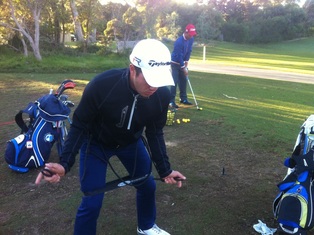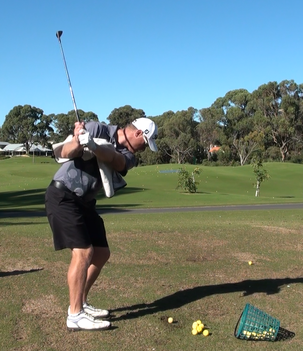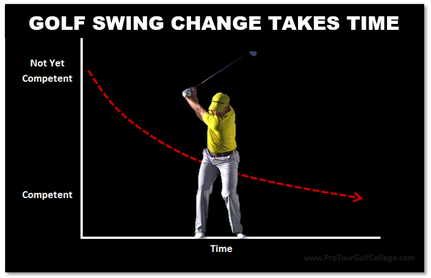 The vast majority of advanced and elite golfers at some point of time in their golfing life will attempt to change some aspect of their golf technique, and sadly most will fail to actually make the change they desire. And it’s not because they don’t have the ability to make the change to their technique, but more because they don’t fully appreciate the scope of the task they are undertaking. So how will they fail? Most likely they will give up well before the change process has had a chance to develop into a habit, and after all, that’s what we’re talking about; creating a new habit or changing an old one. You see, changing a golf stroke pattern is a highly complex endeavour that requires an enormous amount of determination and patience as well as the knowledge of how to go about it so that you actually create lasting change. Typically a golf stroke change for most golfers begins with a visit to your local golf professional where he or she identifies a flaw in your golf technique and suggests a method of change (like a practice drill) that usually revolves around you hitting lots of golf balls to facilitate the change. You then go back for regular consultation with the golf instructor, and your instructor keeps adjusting the stroke pattern and you go away and practice some more, and you come back again and again and somewhere in the future (hopefully) the golf stroke pattern changes and you play the golf of your life or something like that. Sound familiar? Question: How many golf lessons do you think you need to have - and how many golf shots do you need to hit to change your golf swing? You should consider this before you take the plunge. It is a lot more than you think. We suggest that whatever you think the answer to the question is, double it and you'll be half way there.  Changing a golf swing pattern is also called ‘motor skill acquisition’ which simply means a relatively permanent change in technique bought about by practice and experience. When we change movement patterns, golf strokes can become smoother and more precise, leading to more accurate outcomes. We have found that golfers experience more success changing their techniques if they can understand and do these three things. 1. Performing one component of your stroke at a time Isolate just one component of your golf stroke pattern that needs attention, and carefully practice that part of the skill until you have improved its value to the whole. By performing more than one part of the stroke at a time you increase the complexity and decrease your competency. Keep it simple; practice one part at a time. 2. Monitoring your ongoing performance Meaningful feedback is the breakfast of champions. Every successful golfer has a useful feedback system in place to guide the direction of the momentum they’re creating from practice effort. The type of feedback I'm talking about is that of an expert teacher or instructor, someone who can, and has done it at a very high level in their own right, and can show you exactly what to do. Carefully monitor your progress with the help of your golf instructor and also use feedback devices such as video play-back and ball flight monitors. Careful monitoring of your change process will help you to make minor adjustments that will keep you close to the cutting edge of your skills development. Remember, you simply can't improve some aspect of your technique if you can't measure its current position relative to where you want it to be.  3. Determining how to do it better The whole purpose of golf practice is to continually get better at the game of golf. By now you realize that practicing consistently won't automatically improve what you do. You really need to think about your practice methods carefully and thoughtfully before you apply yourself physically to the demands of changing your technique. Many of the golfers we've worked with over the years have a strong desire to get better at the game, but they don't really know how to. Information is useless until you understand how it can help you. Practice is helpful for habituating a new pattern or changing an old one, but you must understand one important thing; change is a biological process first and foremost, and no amount of frustration and anguish will change that fact. You cannot speed up the process of swing change; you can only ensure that you do it carefully and thoughtfully. Successful changing your golf stroke pattern starts with the vision of what’s possible, followed by a deliberate process that introduces the change components carefully, methodically and spaced over a lengthy time period. You simply can’t speed up the change process no matter how hard you try; you can only do a great job of using quality information and instruction from a competent and experienced golf instructor, and lots of carefully executed golf strokes until your new stroke pattern emerges from the land of uncertainty into the land of certainty. Lawrie Montague and David Milne - Pro Tour Golf College The Professional Golf Tour Training College for Serious Amateur Golfers Comments are closed.
|
Archives
June 2019
|
Proudly Supported By
Copyright © 2011 - 2018 Pro Tour Golf College
Website Managed By Golf Performance Media
All Rights Reserved
Website Managed By Golf Performance Media
All Rights Reserved



 RSS Feed
RSS Feed



